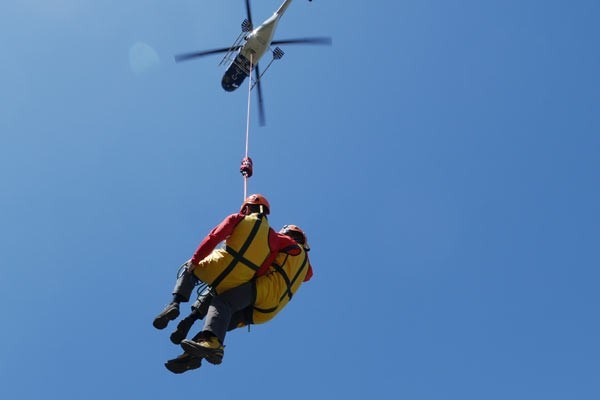When you're stuck between a rock and a hard place, Whistler and Squamish search-and-rescue members will soon be just the people to call. Volunteers from both groups began training last week in a dangerous rescue method that is typically used for injured climbers at high elevations. Called a "high-angle pickoff" rescue, the highly technical manoeuvre involves a helicopter inching close to the injured party so the rescuer can attach themselves to the rock face using a long hook before disconnecting from the chopper. Then, the helicopter will swoop back in and, using a pendulum motion, swing the hook around so the rescuer and the injured climber can reenter the aircraft.
"The real danger here is that instant when you're hooked to both the helicopter and the rock face, because if something goes wrong, it's going to go very wrong," explained Whistler Search and Rescue (WSAR) manager Brad Sills. "This technique is what we use in those couple of seconds when you're attached to both (the rockface and the helicopter)."
Sills believes once the nine members from Whistler and Squamish complete the advanced course, they will be the only search-and-rescue volunteers in the country with that specific training under their belt — Parks Canada is the only other organization he's aware of trained in the technique.
And while he doesn't anticipate the manoeuvre will be used frequently in Whistler, Sills said it should be invaluable for Squamish Search and Rescue — particularly on the Chief, a popular destination for rock climbers.
"It's probably not going to be used all that often, but if you've got somebody who's seriously injured and you've got those resources, it's another tool that you could at least assess to see if it was feasible," added Sills.
WSAR was kept busy this past weekend with two callouts. The first incident involved a 35-year-old male who fractured his femur on a rope swing at Loggers Lake. The swing has been a point of contention in the community in years past, with the municipality regularly taking it down due to safety concerns while some in the resort have called for it to remain in place. In May of 2016, a man was airlifted to hospital after severely injuring himself on the swing. Another man suffered significant head trauma back in 2012 while using a rope swing at Alpha Lake. In 2015, the Resort Municipality of Whistler (RMOW) settled a claim for an undisclosed amount over injuries caused by a rope swing that was installed at the Meadow Park Sports Centre. That swing was removed in 2014.
"You can seriously hurt yourself and I think a lot of people don't comprehend that when they jump on it," Sills said of the Loggers Lake rope swing.
The weekend's second callout was to the Brandywine bowl, where a late-season snowboarder broke his arm after taking a fall.
Sills said WSAR will be receiving two e-bikes this year to assist volunteers heading out to increasingly popular areas such as Rainbow and Sproatt mountains on the west side of the valley.
"We had accessed those areas last year on mountain bikes, but by the time our rescuers get there, they're pretty punched," he noted. "Hopefully there's some juice left in the rescuer with the use of the e-bike by the time he gets there, and he's able to actually do something."




